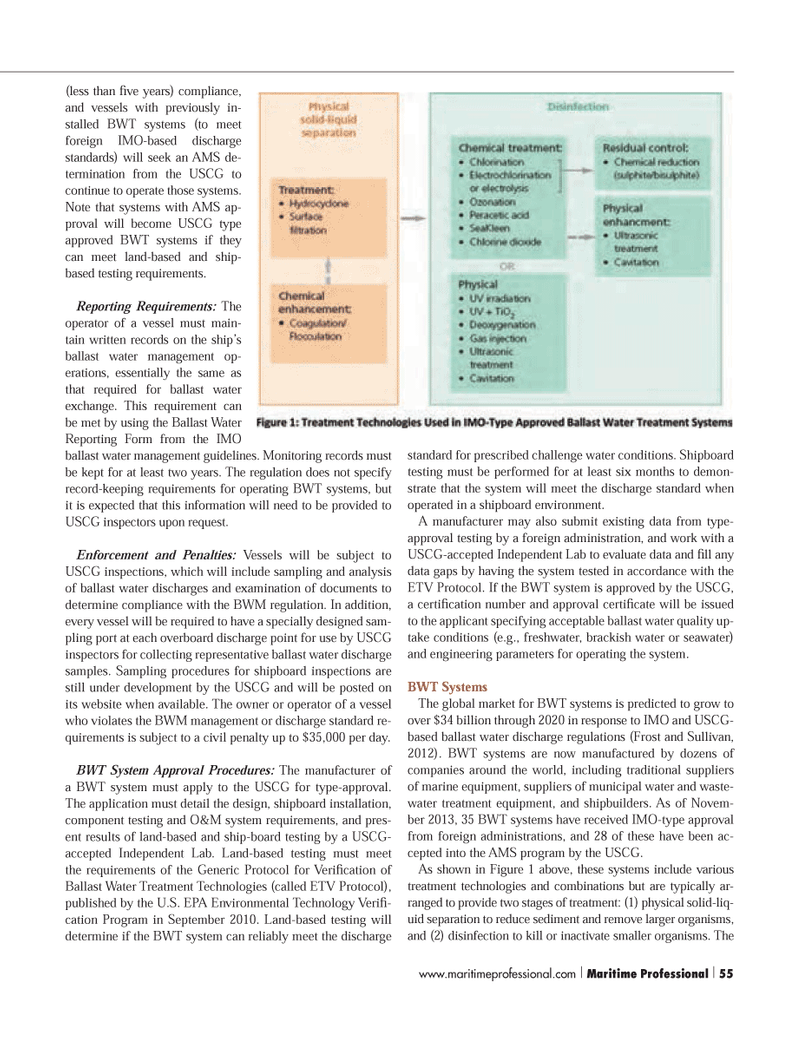
Page 55: of Maritime Logistics Professional Magazine (Q4 2013)
Shipbuilding, Repair
Read this page in Pdf, Flash or Html5 edition of Q4 2013 Maritime Logistics Professional Magazine
(less than Þ ve years) compliance, and vessels with previously in- stalled BWT systems (to meet foreign IMO-based discharge standards) will seek an AMS de- termination from the USCG to continue to operate those systems. Note that systems with AMS ap- proval will become USCG type approved BWT systems if they can meet land-based and ship-based testing requirements.Reporting Requirements: The operator of a vessel must main- tain written records on the shipÕs ballast water management op- erations, essentially the same as that required for ballast water exchange. This requirement can be met by using the Ballast Water Reporting Form from the IMO ballast water management guidelines. Monitoring records must be kept for at least two years. The regulation does not specify record-keeping requirements for operating BWT systems, but it is expected that this information will need to be provided to USCG inspectors upon request.Enforcement and Penalties: Vessels will be subject to USCG inspections, which will include sampling and analysis of ballast water discharges and examination of documents to determine compliance with the BWM regulation. In addition, every vessel will be required to have a specially designed sam- pling port at each overboard discharge point for use by USCG inspectors for collecting representative ballast water discharge samples. Sampling procedures for shipboard inspections are still under development by the USCG and will be posted on its website when available. The owner or operator of a vessel who violates the BWM management or discharge standard re- quirements is subject to a civil penalty up to $35,000 per day. BWT System Approval Procedures: The manufacturer of a BWT system must apply to the USCG for type-approval. The application must detail the design, shipboard installation, component testing and O&M system requirements, and pres-ent results of land-based and ship-board testing by a USCG-accepted Independent Lab. Land-based testing must meet the requirements of the Generic Protocol for VeriÞ cation of Ballast Water Treatment Technologies (called ETV Protocol), published by the U.S. EPA Environmental Technology VeriÞ -cation Program in September 2010. Land-based testing will determine if the BWT system can reliably meet the discharge standard for prescribed challenge water conditions. Shipboard testing must be performed for at least six months to demon-strate that the system will meet the discharge standard when operated in a shipboard environment. A manufacturer may also submit existing data from type- approval testing by a foreign administration, and work with a USCG-accepted Independent Lab to evaluate data and Þ ll any data gaps by having the system tested in accordance with the ETV Protocol. If the BWT system is approved by the USCG, a certiÞ cation number and approval certiÞ cate will be issued to the applicant specifying acceptable ballast water quality up- take conditions (e.g., freshwater, brackish water or seawater) and engineering parameters for operating the system.BWT SystemsThe global market for BWT systems is predicted to grow to over $34 billion through 2020 in response to IMO and USCG-based ballast water discharge regulations (Frost and Sullivan, 2012). BWT systems are now manufactured by dozens of companies around the world, including traditional suppliers of marine equipment, suppliers of municipal water and waste- water treatment equipment, and shipbuilders. As of Novem- ber 2013, 35 BWT systems have received IMO-type approval from foreign administrations, and 28 of these have been ac- cepted into the AMS program by the USCG. As shown in Figure 1 above, these systems include various treatment technologies and combinations but are typically ar- ranged to provide two stages of treatment: (1) physical solid-liq- uid separation to reduce sediment and remove larger organisms, and (2) disinfection to kill or inactivate smaller organisms. The www.maritimeprofessional.com | Maritime Professional | 55MP #4 50-63.indd 55MP #4 50-63.indd 5512/11/2013 2:14:29 PM12/11/2013 2:14:29 PM

 54
54

 56
56
